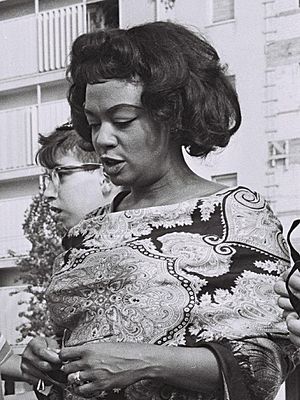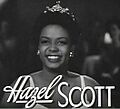Hazel Scott facts for kids
Quick facts for kids
Hazel Dorothy Scott
|
|
|---|---|

Scott in the trailer for Rhapsody in Blue (1945).
|
|
| Born | June 11, 1920 Port of Spain, Trinidad and Tobago
|
| Died | October 2, 1981 (aged 61) New York City, U.S.
|
| Known for | The first black American to host her own TV show, The Hazel Scott Show |
Hazel Dorothy Scott (born June 11, 1920 – died October 2, 1981) was an amazing American jazz and classical pianist and singer. She was born in Trinidad. Hazel Scott was also a strong voice against racial discrimination and segregation. She used her fame to help improve how Black Americans were shown in movies.
Scott moved to New York City with her mother when she was four. She was a musical genius from a young age. She even received scholarships to study at the famous Juilliard School when she was only eight. As a teenager, she performed in popular clubs like Café Society and on the radio.
She became a well-known jazz singer in the 1930s and 1940s. In 1950, she made history as the first Black American to host her own TV show, The Hazel Scott Show. Her career in America faced challenges after she spoke to the House Un-American Activities Committee in 1950. This was during a time called McCarthyism. Scott then moved to Paris in 1957 and performed in Europe. She did not return to the United States until 1967.
Contents
Early Life and Musical Talent
Hazel Dorothy Scott was born in Port of Spain, Trinidad and Tobago, on June 11, 1920. She was the only child of R. Thomas Scott and Alma Long Scott. Her mother was a trained pianist and music teacher. In 1924, Hazel and her family moved from Trinidad to the United States. They settled in Harlem, New York City. Her parents had separated by this time. Hazel lived with her mother and grandmother.
From a very young age, Hazel could play any song she heard on the piano. With her mother's help, she learned advanced piano skills. People called her a child prodigy because of her amazing talent. When Scott was eight years old, Professor Paul Wagner from the Juilliard School of Music accepted her as his student. In 1933, her mother started her own all-girl jazz band. Hazel played both the piano and trumpet in this band.
A Star on Stage and Screen
By the age of 16, Hazel Scott was a regular on radio shows for the Mutual Broadcasting System. She became known as the "hot classicist" because she mixed classical music with swing. In the mid-1930s, she also performed at the Roseland Dance Hall with the famous Count Basie Orchestra. She appeared in several musical shows in New York. These included the Cotton Club Revue of 1938 and The Priorities of 1942.
Throughout the 1930s and 1940s, Scott performed many types of music. She played jazz, blues, ballads, Broadway songs, and boogie-woogie. She also played classical music in various nightclubs. Barney Josephson, the owner of Café Society, wanted a place where artists of all races could perform. From 1939 to 1943, Hazel Scott was a main attraction at both Café Society locations. Her performances helped make "swinging the classics" famous across the country. By 1945, Scott was earning a lot of money, showing her success.
Breaking Barriers in Hollywood
Hazel Scott, along with Lena Horne, was one of the first Black women to get respected roles in big Hollywood movies. She refused to play roles that showed Black women as "singing maids." She turned down the first four roles she was offered for this reason. When she did act in Hollywood films, she made sure she had control over how she looked. She wanted to protect her image.
She appeared as herself in films like I Dood It (1943), Broadway Rhythm (1944) with Lena Horne, and Rhapsody in Blue (1945). In total, she was in five Hollywood films. She always insisted on being credited as "Miss Hazel Scott as Herself." She also wore her own clothes and jewelry. Her final disagreement with Columbia Pictures was over a costume. She felt it used a harmful stereotype about Black people. In the 1940s, she also performed in special concerts at Carnegie Hall. These concerts were called From Bach to Boogie-Woogie.

First Black TV Show Host
Hazel Scott was the first person of African descent to have her own television show in America. It was called The Hazel Scott Show. The show first aired on the DuMont Television Network on July 3, 1950. Variety magazine said that "Hazel Scott has a neat little show." They added that Scott herself was its "most engaging element." The show became very popular and soon aired three times a week. On her show, Scott performed with talented jazz musicians. These included Charles Mingus and Max Roach.
Activism and Challenges
Fighting for Civil Rights
Hazel Scott was always dedicated to civil rights. She refused to perform in places that had segregated audiences. This meant Black and white people had to sit separately. Once, she was even escorted out of Austin, Texas, by Texas Rangers. This happened because she would not perform after finding out that Black and white patrons were seated apart. She told Time magazine, "Why would anyone come to hear me, a Negro, and refuse to sit beside someone just like me?"
In 1949, Scott sued the owners of a restaurant in Pasco, Washington. A waitress there refused to serve Scott and her friend because they were Black. Scott won the case. Her victory helped African Americans fight racial discrimination in Spokane. It also inspired civil rights groups to push for new laws. This led to the Public Accommodations Act in Washington state in 1953.
Facing McCarthyism
During the Red Scare, many people in the entertainment industry were accused of being communists. In June 1950, Scott's name appeared in a report called Red Channels. This report listed people thought to have communist ties. To clear her name, Scott willingly appeared before the House Un-American Activities Committee (HUAC) on September 22, 1950. She insisted on reading a statement she had prepared. She said she was never knowingly connected to the Communist Party.
However, she did say she supported Benjamin J. Davis, a Communist Party member, for City Council. She explained that Davis was also supported by socialists. Scott also shared her frustration about the many false accusations against entertainers. She suggested using "democratic methods" to stop irresponsible charges. Scott ended her statement by asking that entertainers not be "covered with the mud of slander" when proving their loyalty.
Her television show, The Hazel Scott Show, was canceled just one week after she appeared before HUAC. This happened on September 29, 1950. Scott suffered a nervous breakdown in 1951. After she recovered, she continued to perform in the United States and Europe. She even made occasional appearances on TV shows. Her short-lived TV show had given hope to African American viewers. This was a time of racial bias in broadcasting and financial struggles for jazz musicians. Scott continued to speak out against McCarthyism and racial segregation throughout her career.
Life in France (1957–1967)
To avoid the political problems in the United States, Scott moved to Paris in 1957. She appeared in a French film called Le désordre et la nuit (1958). In 1963, she joined other African-American people living abroad. They marched to the US Embassy in Paris to show support for the upcoming March on Washington.
Return to the US (1967–1981)
Hazel Scott did not return to the US until 1967. By this time, the Civil Rights Movement had made big changes. New laws made racial segregation illegal in housing and public places. They also protected the voting rights of all citizens.
Scott continued to perform in nightclubs sometimes. She also appeared on daytime television until the year she passed away. In 1973, she made her acting debut on a TV show called One Life to Live. She played a wedding song for her "onscreen cousin" Carla Gray Hall.
Personal Life
In 1945, Hazel Scott married Adam Clayton Powell Jr., a Baptist minister and US Congressman. They had one child, Adam Clayton Powell III. The couple divorced in 1960 after being separated.
On January 19, 1961, Scott married Ezio Bedin. He was a Swiss-Italian comedian who was fifteen years younger than her. They divorced a few years later, before she returned to the US.
Her Faith
Hazel Scott was also a member of the Baháʼí Faith. She joined the religion after meaningful conversations with jazz legend Dizzy Gillespie. Scott also sang at an award dinner in New York in 1970. She performed songs like When the World was Young. Her singing was praised by Whitney Young, a leader of the National Urban League. In May 1971, Scott co-presented a musical in Kingston, Jamaica. It was called "The Sounds of a New World." She performed with Dizzy Gillespie and others as part of a Bahá’í conference.
Later Years and Legacy
On October 2, 1981, Hazel Scott died of cancer at Mount Sinai Hospital in Manhattan. She was 61 years old. She was survived by her son, Adam Clayton Powell III. She is buried at Flushing Cemetery in Queens, New York. Many other famous musicians, like Louis Armstrong and Dizzy Gillespie, are also buried there.
Scott was known as an amazing jazz pianist. She also had success in acting and classical music. She used her fame as one of the best-known African-American entertainers of her time. She shined a light on important issues like racial injustice and civil rights.
Scott recorded music as the leader of different groups. These included a trio with Bill English and Martin Rivera. Another trio featured Charles Mingus and Max Roach. Her 1955 album Relaxed Piano Moods is still highly praised by music critics today. Her unique style, mixing jazz and classical music, kept her in demand for performances throughout her life.
Singer-songwriter Alicia Keys said Hazel Scott inspired her performance at the 61st Grammy Awards. Keys said, "I've been thinking about people who inspire me; shout out to Hazel Scott, I've always wanted to play two pianos."
In 2020, the BBC World Service featured her in a program called Hazel Scott: Jazz star and barrier breaker. This was part of their series The Forum. In the book "When Women Invented Television," author Jennifer Keishin Armstrong highlights Scott. She is one of four women who greatly influenced television. In 2022, the Dance Theatre of Harlem created a new ballet about Hazel Scott's life.
Selected Music Albums
- Swinging the Classics: Piano Solos in Swing Style with Drums (1941)
- Her Second Album of Piano Solos with Drums Acc. (1942)
- A Piano Recital (1946)
- Great Scott! (1948)
- Two Toned Piano Recital (1952)
- Hazel Scott's Late Show (1953)
- Relaxed Piano Moods (1955)
- 'Round Midnight (1957)
- Always (1979)
- After Hours (1983)
Images for kids
See also
 In Spanish: Hazel Scott para niños
In Spanish: Hazel Scott para niños







